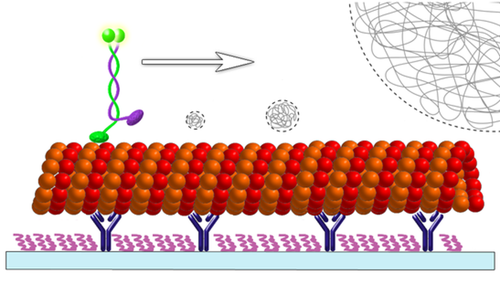Stalling a Molecular Motor
The motor protein kinesin transports large molecular cargo from place to place inside animal and plant cells. Researchers allowed isolated kinesin motors to operate in fluids with a range of viscosities, including fluids chosen to directly affect the motor’s internal workings. The experiments showed that the kinesin motor stops moving, or stalls, under a drag force that is 100,000 times smaller than the maximum load it can pull. The authors’ explanation for this seeming discrepancy is that the viscous drag disrupts the timing of the molecular motion, rather than simply pushing against it. The results support the theory that kinesin moves by channeling random thermal motions.
Kinesin’s main role is in transporting large proteins and vesicles along thin polymers, called microtubules, that form a “road network” within a cell. The motor molecule has two leg-like appendages that “walk” along the road. The “feet” of the kinesin legs can bind and unbind from microtubule sites that repeat every 8 nanometers. A single step occurs when the trailing leg frees itself from one site on the microtubule and a few milliseconds later reattaches at the next site in the forward direction. How the leg strides forward has been a matter of debate. Does the molecule generate a forward force on the freed leg? Or does the freed leg randomly flop around in response to thermal fluctuations, and the molecule merely helps direct this diffusion by leaning forward?
Several studies have investigated the motor mechanism by applying an external force to slow or stop kinesin. For example, researchers have placed kinesin in an optical trap and found that it could not move forward against a force (maximum load) of 7 piconewtons [1]. Other experiments have used viscous fluids to slow the molecule’s progress [2, 3]. This research has generally favored the picture involving random diffusion of the leg, known as the “Brownian ratchet” model. However, past experiments have only addressed this issue indirectly, by applying forces on the cargo tethered to the motor, rather than the kinesin molecule itself.
To probe the leg motion directly, Robert Hołyst of the Polish Academy of Sciences in Warsaw and his colleagues chose viscous fluids that could produce drag at the scale of the kinesin molecule. As in previous viscosity experiments [3], the researchers thickened the fluid using polymers that ball up and function as clumps, or “crowders,” rather than spread-out strings. The team selected crowders—some as small as a nanometer wide—that would exert drag on the long but relatively thin kinesin molecule. Previous experimenters focused on obstructing wide cargo items, such as plastic beads.
In their experiments, Hołyst and his colleagues placed cargo-less kinesin on microtubules in solutions with a range of different viscosities and crowder sizes. The team monitored the kinesin’s walking speed with the help of fluorescent markers embedded in the kinesin molecule.
They found that kinesin moved slower in the more viscous fluids, as expected, but they were surprised that they could halt its motion entirely with a drag force of about 0.1 femtonewtons, 100,000 times smaller than the maximum load measured previously. The small stalling force implies that kinesin does not generate a forward force; instead the data favor the Brownian ratchet model, the researchers write. In this model, the kinesin leans forward for about 10 milliseconds, to favor forward diffusion of the freed leg. Normally, that is plenty of time, but under high viscosity conditions, the leg takes too long to diffuse and misses its window of opportunity. In previous experiments, larger crowders could not interfere with the motor at this microscopic scale. Hołyst speculates that drug developers might one day be able to take advantage of this viscosity effect to control kinesin behavior in malfunctioning cells.
“I like the original approach of this new experimental work,” says Jed Macosko of Wake Forest University in North Carolina. He agrees that it provides further support for the Brownian ratchet model. Moreover, the inside of a cell is highly viscous, so similar experiments may reveal new aspects of kinesin behavior, such as ways to increase the motor speed with a combination of different crowders, Macosko says.
This research is published in Physical Review Letters.
–Michael Schirber
Michael Schirber is a Corresponding Editor for Physics Magazine based in Lyon, France.
References
- N. J. Carter and R. A. Cross, “Mechanics of the Kinesin Step,” Nature 435, 308 (2005).
- J. Gagliano, M. Walb, B. Blaker, J.C. Macosko, and G. Holzwarth, “Kinesin Velocity Increases with the Number of Motors Pulling Against Viscoelastic Drag,” Eur. Biophys. J. 39, 801 (2009).
- A. J. Hunt, F. Gittes, and J. Howard, “The Force Exerted by a Single Kinesin Molecule Against a Viscous Load,” Biophys. J. 67, 766 (1994).
More Information
Molecular motors (scroll down for detailed video of walking kinesin) from Ron Vale's research group at the University of California, San Francisco





